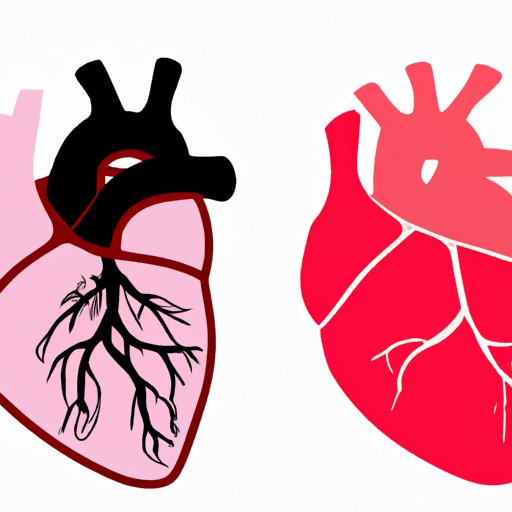Introduction
The heart is an essential organ in our body that pumps blood to the different parts of our system. It is crucial to understand the anatomy and function of the heart’s chambers to maintain overall cardiovascular health. The human heart is a four-chambered organ that works efficiently to ensure blood is pumped throughout the body. In this article, we’ll explore the anatomy and function of the heart’s chambers, the evolution of heart chambers in different species, and other fascinating aspects of the human heart.
Understanding the Anatomy of the Heart: The Four Chambers Explained
The human heart is divided into four chambers: the right atrium, the right ventricle, the left atrium, and the left ventricle. The right atrium is a thin-walled chamber that receives deoxygenated blood from the veins and pumps it into the right ventricle through a valve called the tricuspid valve. The right ventricle is a thick-walled chamber that pumps the deoxygenated blood to the lungs to get oxygenated. The left atrium is another thin-walled chamber that receives oxygenated blood from the lungs through the pulmonary veins and pumps it into the left ventricle through the mitral valve. The left ventricle is the thickest and most muscular chamber of the heart, which pumps oxygenated blood into the aorta, the body’s main artery.
Understanding the function of each chamber is essential to understand how the heart works. The right atrium and ventricle work together to pump deoxygenated blood to the lungs, where it receives oxygen and releases carbon dioxide. The left atrium and ventricle work together to pump oxygenated blood throughout the rest of the body.
The Significance of the Heart’s Four Chambers in Maintaining Cardiovascular Health
Each chamber of the heart plays a crucial role in maintaining cardiovascular health. The right atrium and ventricle ensure that oxygen-depleted blood circulation to the lungs is efficiently carried out. The left atrium and ventricle play an essential role in maintaining proper blood flow and circulation, ensuring that oxygenated blood circulates throughout the body, supplying the necessary nutrients to the tissues and organs.
Moreover, the heart’s ability to pump blood through the four chambers depends on several factors, including the overall health of the heart, the efficiency of each chamber, and blood pressure. Any issues in any of the four chambers lead to inadequate blood circulation, which can result in various cardiovascular diseases such as heart attacks, heart failure, or arrhythmia. It is, therefore, necessary to monitor the heart chambers’ health and take steps towards maintaining overall cardiovascular health.
From Fish to Mammals: The Evolution of the Number of Heart Chambers
The human heart has four chambers, but that’s not the case for all animals. Invertebrates such as octopus and squids have three hearts, while earthworms have five heart chambers. Fish have two chambers, while birds have four. However, the majority of mammals, including humans, have four heart chambers.
The evolution of the heart chambers in different animals is fascinating. Fish originated from invertebrates and evolved a two-chambered heart to pump blood to the gills, where it gets oxygenated. As animals learned to evolve and move around on land, the heart’s chambers evolved to accommodate this change.
Busting Myths About the Heart’s Chambers: Debunking Common Misconceptions
There are several myths associated with the heart’s chambers that need to be debunked. One of the most prevalent myths is that the left side of the heart is more critical than the right side. In reality, both the right and left side of the heart are equally essential in ensuring that blood is pumped efficiently throughout the body. Another common myth is that the heart’s chambers can be trained like any other muscle through exercise. The heart is indeed a muscle, but it doesn’t work like other muscles in our system since it needs to pump blood continuously.
The Role of Each Chamber in the Heart’s Function: A Comprehensive Overview
The right atrium and ventricle: The right atrium receives deoxygenated blood from the veins and pumps it into the right ventricle. From there, the right ventricle pumps this blood to the lungs, where it is oxygenated before returning to the heart.
The left atrium and ventricle: The left atrium receives oxygen-rich blood from the lungs and pumps it into the left ventricle. The left ventricle then pumps this blood into the aorta, which distributes oxygenated blood to the rest of the body.
The Development of Congenital Heart Defects Related to Abnormal Number of Heart Chambers
Congenital heart defects are relatively common in newborns and can occur due to several factors. These defects can affect the number of heart chambers, making it abnormal or defective. Any issues with the heart chambers can lead to inadequate blood circulation, which can result in life-threatening situations.
Some of the causes of congenital heart defects include genetics, mother’s health during pregnancy, and exposure to environmental toxins. Treatments for congenital heart defects vary depending on the severity of the condition, but they may include medication, surgery, or cardiac catheterization.
Comparing the Heart Structures of Different Species: How Many Chambers Do Various Animals Have?
As mentioned earlier in this article, different animals have varying numbers of heart chambers. Fish have two chambers, while birds have four and invertebrates like squids have three. The number of chambered hearts reflects the animal’s needs and lifestyle. Animals that need to pump blood more efficiently, such as mammals, generally have more complex and efficient heart structures than other animals.
Conclusion
The heart’s chambers play a vital role in maintaining overall cardiovascular health. Understanding the anatomy and function of each chamber is crucial in ensuring that the heart pumps efficiently, and blood is circulated throughout the body. It is essential to be proactive about our cardiovascular health and take steps towards maintaining an optimal lifestyle. By understanding the evolution, function, and structure of the heart’s chambers, we can take the necessary steps to ensure a healthy heart.
